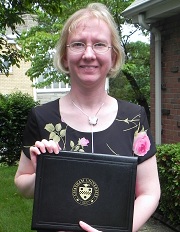
Chatham University Graduate Student Uses Museum Archives to Research Thesis
 |
| Rebekah Johnston with her Chatham University diploma |
The permanent archives and collections of the Beaver Area Heritage Museum are a valuable educational resource, not just to citizens of Beaver, but to scholars and historians everywhere. Rebekah Johnston, a graduate student in landscape architecture at Chatham University in Pittsburgh, is one such individual. For her master’s thesis, Johnston has prepared a cultural landscape report of Beaver and its central public squares. Her cultural landscape report evaluates and documents, in simple terms, the history Beaver and the use of the central public squares.
Johnston focused on the public squares of Beaver after consulting with her advisor, and contacting four counties. Johnston, impressed by the helpfulness of Beaver’s County Tourism Office, did a Google Earth search to learn more about our public squares, then came to see them in person in late 2010. Johnston’s research led her to Carnegie Library in Pittsburgh, which has microfilms of the Beaver Argus, a predecessor to the Beaver County Times, as well as to the Senator John Heinz History Center, the Beaver County Genealogy and History Center, and the archives of our museum.
Ancient Beaver Borough meeting minutes, held in the museum’s archives, began documentation in 1812, and Johnston reviewed them through the 1950s. The archives were especially helpful, she said, in learning about the different committees and organizations involved in improvements to the public squares.
Johnston concluded her thesis in April 2012 with a formal defense of the findings. The thesis not only contains important historical facts on Beaver but also analyzes the connection that Beaver was based as a grid pattern town on the model of Philadelphia, the first city to be surveyed as a grid. Analysis showed that Beaver’s layout has changed very little since the original survey or 1793 and the important use of the central public squares through the same time frame of the changes to the town.
The final conclusions of the thesis document the importance of preservation and conclude with treatment recommendations for McIntosh Square, one of the three public squares that have essentially remained the same since the installation of the prominent Soldiers and Sailors Monument. Her cultural landscape report considers three areas for treatment recommendations:
- Rehabilitation, the process of making possible a compatible use for the property through alteration or addition (such as the gazebo in Irvine Park), while preserving those features that convey historical value;
- Restoration depicts the form, features and character of a property as it appeared at a particular time period, by removing features from other time periods and reconstructing missing features from the restoration period; and
- Reconstruction is the act of replicating a site’s appearance and features at a specific period of time and in its historic location (ie, rebuilding the fort). For the thesis reconstruction was ruled out because of any lack of formal change to structure or site feature in McIntosh Square. The final thesis recommended rehabilitation of McIntosh Square when the public square transitioned from common ground to leisure park during the years of the late 1860s through the early 1900s and complete restoration of the Soldiers and Sailors Monument with emphasis on continual maintenance of the monument.
A printed copy of the thesis has been donated to the Heritage Museum, along with photographs taken during the research process.
Johnston will speak at the Heritage Foundation’s annual membership meeting on Nov. 20, 2012, presenting on her thesis and answering questions.
— By Paula Soto